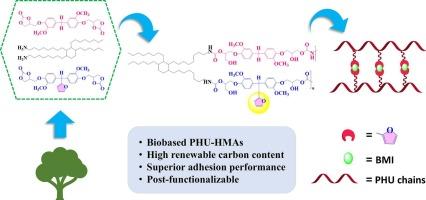Post-functionalizable and reusable biobased polyhydroxyurethane adhesives with pendant furyl groups
IF 5.1
3区 工程技术
Q1 CHEMISTRY, APPLIED
引用次数: 0
Abstract
Polyurethane hot melt adhesives (PU-HMAs) are essential in various industries due to their fast-setting properties, strong adhesion, and versatility across a wide range of substrates. However, conventional fossil-based PU-HMAs face significant challenges, including reliance on non-renewable resources, high environmental impact, and the use of hazardous isocyanates, which pose health and safety concerns. To address these issues, this study focuses on developing sustainable, high-performance PHU-HMAs containing pendant furyl groups for metal bonding. A series of adhesives were developed utilizing varying proportions of two biobased dicarbonates derived from lignin and sugar: one featuring a pendant furyl group (BGF-PF-DC) and another without the pendant group (BGF-DC), in conjunction with Priamine 1074. The study comprehensively examined the effects of these formulations on the physio-mechanical, thermal, and adhesive properties. The results demonstrated an impressive renewable carbon content of 89–90 %, high adhesion strength of up to 9.27 MPa on aluminum and 9.43 MPa on stainless steel, excellent underwater adhesion, and outstanding reusability. Furthermore, the post-modifiability of pendant furyl in PHU6-PF100 was evaluated through cross-linking via the Diels-Alder reaction with bismaleimides (BMI). This study also examined the effects of these modifications on both the adhesive performance and thermal characteristics of the modified PHUs. However, the postmodified PHU/BMI network showed a decrease in adhesion but exhibited a higher glass transition temperature and improved adhesion stability at 50 °C compared to PHU6-PF100. This study emphasizes the sustainable and high-performance potential of PHU-based hot melt adhesives, establishing them as a viable alternative to traditional isocyanate-based systems. Furthermore, it introduces new opportunities for incorporating Diels-Alder (DA) chemistry into PHU adhesives, which allows for stable adhesion at elevated temperatures and broadens their applicability across various industries. Additionally, this research can serve as a foundation for future studies to investigate thermoreversibility in thermosetting PHUs, potentially expanding their range of applications even further.

后功能化和可重复使用的生物基聚羟基聚氨酯粘合剂
聚氨酯热熔胶(PU-HMAs)在各种行业中都是必不可少的,因为它们具有快速凝固的特性,强附着力,以及在各种基材上的通用性。然而,传统的化石基pu - hma面临重大挑战,包括对不可再生资源的依赖、对环境的高影响以及使用有害的异氰酸酯,这些都构成了健康和安全问题。为了解决这些问题,本研究的重点是开发可持续的、高性能的PHU-HMAs,其中包含金属键合的垂坠呋喃基。利用从木质素和糖中提取的两种生物基二碳酸酯的不同比例开发了一系列粘合剂:一种具有垂坠基(BGF-PF-DC),另一种不具有垂坠基(BGF-DC),与Priamine 1074一起使用。该研究全面考察了这些配方对物理力学、热学和粘合性能的影响。结果表明,其可再生碳含量高达89 - 90%,与铝的结合强度高达9.27 MPa,与不锈钢的结合强度高达9.43 MPa,具有出色的水下附着力和出色的可重复使用性。此外,通过Diels-Alder反应与双马来酰亚胺(BMI)进行交联,评价了PHU6-PF100中悬垂呋喃基的后修饰性。本研究还考察了这些改性对改性phu的粘接性能和热特性的影响。然而,与PHU6-PF100相比,经过修饰的PHU/BMI网络的附着力有所下降,但在50℃时表现出更高的玻璃化转变温度和更好的附着力稳定性。这项研究强调了phu基热熔胶的可持续和高性能潜力,将其作为传统异氰酸酯基系统的可行替代品。此外,它还为PHU粘合剂中加入Diels-Alder (DA)化学物质带来了新的机会,这使得PHU粘合剂在高温下具有稳定的附着力,并拓宽了其在各个行业的适用性。此外,该研究可以作为未来研究热固性phu的热可逆性的基础,有可能进一步扩大其应用范围。
本文章由计算机程序翻译,如有差异,请以英文原文为准。
求助全文
约1分钟内获得全文
求助全文
来源期刊

Reactive & Functional Polymers
工程技术-高分子科学
CiteScore
8.90
自引率
5.90%
发文量
259
审稿时长
27 days
期刊介绍:
Reactive & Functional Polymers provides a forum to disseminate original ideas, concepts and developments in the science and technology of polymers with functional groups, which impart specific chemical reactivity or physical, chemical, structural, biological, and pharmacological functionality. The scope covers organic polymers, acting for instance as reagents, catalysts, templates, ion-exchangers, selective sorbents, chelating or antimicrobial agents, drug carriers, sensors, membranes, and hydrogels. This also includes reactive cross-linkable prepolymers and high-performance thermosetting polymers, natural or degradable polymers, conducting polymers, and porous polymers.
Original research articles must contain thorough molecular and material characterization data on synthesis of the above polymers in combination with their applications. Applications include but are not limited to catalysis, water or effluent treatment, separations and recovery, electronics and information storage, energy conversion, encapsulation, or adhesion.
 求助内容:
求助内容: 应助结果提醒方式:
应助结果提醒方式:


